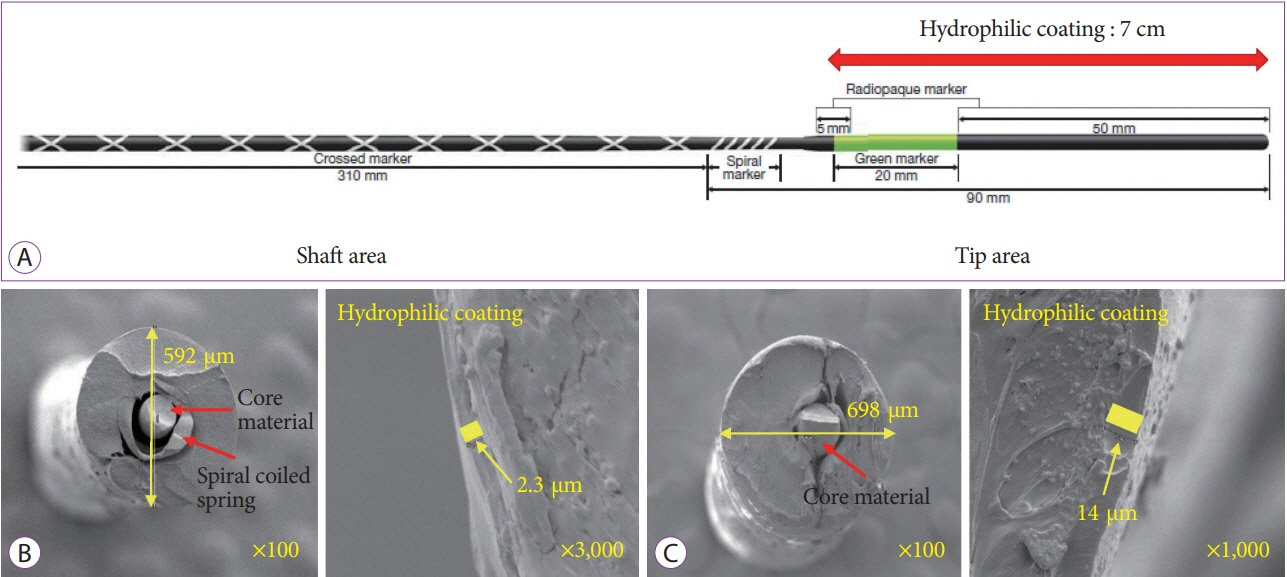Clin Endosc.
2020 Jan;53(1):65-72. 10.5946/ce.2019.114.
Technical Reports of Endoscopic Retrograde Cholangiopancreatography Guidewires on the Basis of Physical Properties
- Affiliations
-
- 1Digestive Disease Center, CHA Bundang Medical Center, CHA University School of Medicine, Seongnam, Korea
- 2Research Group for Endoscopic Instruments and Stents, Korean Society of Gastrointestinal Endoscopy, Seoul, Korea
- 3Division of Gastroenterology, Department of Internal Medicine, Hallym University Dongtan Sacred Heart Hospital, Hallym University College of Medicine, Hwaseong, Korea
- 4Division of Gastroenterology, Department of Internal Medicine, Ulsan University College of medicine, Asan medical center, Seoul, Korea
- 5Division of Gastroenterology, Department of Internal Medicine, Daejeon St. Mary’s Hospital, College of Medicine, The Catholic University of Korea, Daejeon, Korea
- 6Division of Gastroenterology, Department of Internal Medicine, Inha University Hospital, Inha University School of Medicine, Incheon, Korea
- KMID: 2500907
- DOI: http://doi.org/10.5946/ce.2019.114
Abstract
- Background/Aims
Using an appropriate guidewire can increase the success rate of selective cannulation in endoscopic retrograde cholangiopancreatography. The purpose of this technical study was to investigate the characteristics of each guidewire type and to evaluate its efficiency and rapidity of insertion.
Methods
We conducted a three-point bending test using a universal testing machine to investigate the flexibility and bending features of each guidewire. 3D-printed silicone tubes with various types of stricture and a hand-made biliary tree silicone model with six-stranded intrahepatic ducts were used to evaluate the success rate and insertion time of each guidewire.
Results
In the three-point bending test, the characteristics of each guidewire were classified. We found that the bending strengths and times were independent of shaft thickness. Using two in vitro biliary duct models, we determined that the success rate and total insertion time were better for guidewires with a resilient shaft and angled tip than for other types of guidewires (p<0.001). Although thickness of the guidewire affected the success rate (p<0.05), it did not affect the total insertion time (p≥0.05).
Conclusions
Among several types of guidewire, some factors (resilient shaft, highly flexible, and angled tip) appeared to be associated with the efficiency and rapidity of the guidewire insertion.
Figure
Cited by 2 articles
-
Technical Review of Developments in Endoscopic Ultrasound-Guided Hepaticogastrostomy
Takeshi Ogura, Kazuhide Higuchi
Clin Endosc. 2021;54(5):651-659. doi: 10.5946/ce.2021.020-KDDW.만성췌장염 환자에서 내시경역행담췌관조영술 시 발생한 주췌관 내 유도선 감입: 증례 보고
Soyoung Kim, Hoonsub So, Seok Won Jung, Sung Jo Bang
Korean J Gastroenterol. 2023;81(1):36-39. doi: 10.4166/kjg.2022.121.
Reference
-
1. Somogyi L, Chuttani R, Croffie J, et al. Guidewires for use in GI endoscopy. Gastrointest Endosc. 2007; 65:571–576.
Article2. Lee TH, Jung YK, Park SH. Preparation of high-risk patients and the choice of guidewire for a successful endoscopic retrograde cholangiopancreatography procedure. Clin Endosc. 2014; 47:334–340.
Article3. Kawakami H, Maguchi H, Mukai T, et al. A multicenter, prospective, randomized study of selective bile duct cannulation performed by multiple endoscopists: the BIDMEN study. Gastrointest Endosc. 2012; 75:362–372. 372.e1.
Article4. Cennamo V, Fuccio L, Zagari RM, et al. Can a wire-guided cannulation technique increase bile duct cannulation rate and prevent post-ERCP pancreatitis?: a meta-analysis of randomized controlled trials. Am J Gastroenterol. 2009; 104:2343–2350.
Article5. Lee TH, Park DH, Park JY, et al. Can wire-guided cannulation prevent post-ERCP pancreatitis? A prospective randomized trial. Gastrointest Endosc. 2009; 69(3 Pt 1):444–449.
Article6. Katsinelos P, Paroutoglou G, Kountouras J, et al. A comparative study of standard ERCP catheter and hydrophilic guide wire in the selective cannulation of the common bile duct. Endoscopy. 2008; 40:302–307.
Article7. Artifon EL, Sakai P, Cunha JE, Halwan B, Ishioka S, Kumar A. Guidewire cannulation reduces risk of post-ERCP pancreatitis and facilitates bile duct cannulation. Am J Gastroenterol. 2007; 102:2147–2153.
Article8. Bailey AA, Bourke MJ, Williams SJ, et al. A prospective randomized trial of cannulation technique in ERCP: effects on technical success and post-ERCP pancreatitis. Endoscopy. 2008; 40:296–301.
Article9. Tse F, Yuan Y, Moayyedi P, Leontiadis GI. Guidewire-assisted cannulation of the common bile duct for the prevention of post-endoscopic retrograde cholangiopancreatography (ERCP) pancreatitis. Cochrane Database Syst Rev. 2012; 12:CD009662.
Article10. Omuta S, Maetani I, Shigoka H, et al. Newly designed J-shaped tip guidewire: a preliminary feasibility study in wire-guided cannulation. World J Gastroenterol. 2013; 19:4531–4536.
Article11. Park JS, Jeong S, Lee DH. Effectiveness of a novel highly flexible-tip guidewire on selective biliary cannulation compared to conventional guidewire: randomized controlled study. Dig Endosc. 2018; 30:245–251.
Article
- Full Text Links
- Actions
-
Cited
- CITED
-
- Close
- Share
- Similar articles
-
- Usefulness of the double-guidewire technique for endoscopic procedures in the field of biliary and pancreatic diseases
- Preparation of High-Risk Patients and the Choice of Guidewire for a Successful Endoscopic Retrograde Cholangiopancreatography Procedure
- Endoscopic ultrasound-directed transgastric endoscopic retrograde cholangiopancreatography for patients with Roux-en-Y gastric bypass anatomy: technical overview
- Endoscopic Retrograde Cholangiopancreatography and Endoscopic Sphincterotomy in Patients with a Previous Billroth-II Resection
- Four Cases of Guidewire Induced Periampullary Perforation During Endoscopic Retrograde Cholangiopancreatography






